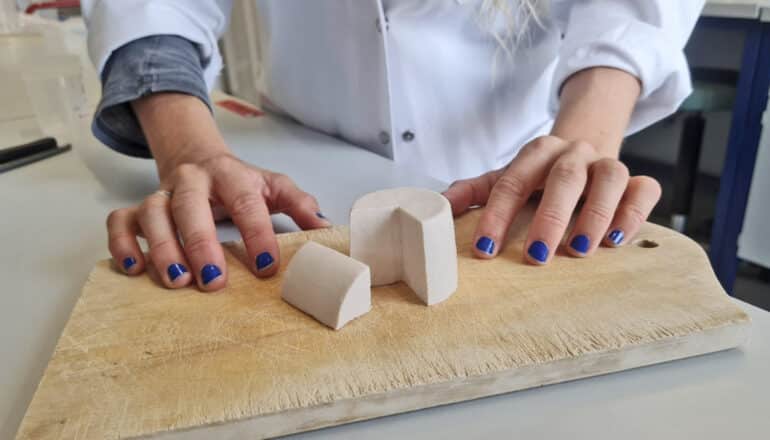
New research shows the potential of fermentation for producing plant-based cheese that people want to eat.
Increasing pressure on Earth's resources and climate change calls for our food system to turn in a more plant-based direction. As a result, scientists are looking into how to transform protein-rich plants like peas and beans into a new generation of non-dairy cheeses that possess the similar sensory properties as the dairy-based ones that humans have enjoyed for thousands of years.
Several plant-based cheeses are already on the market. The challenge is that plant proteins behave differently than milk proteins. To meet this challenge, producers add starch or coconut oil to harden plant cheeses, as well as an array of flavorings to make them taste like cheese.
But it turns out that this can be done with the help of nature's smallest creatures. In a new research result from the University of Copenhagen's food science department, researcher Carmen Masiá has succeeded in developing plant-based cheeses made from yellow pea protein with a firm texture and improved aroma profile. She used the same natural fermentation process with bacteria that we have used with cheeses made from milk for thousands of years.
“Fermentation is an incredibly powerful tool to develop flavor and texture in plant-based cheeses. In this study, we show that bacteria can serve to develop firmness in non-dairy cheese in a very short period of time while reducing the bean-like aroma of yellow pea protein, which is used as the main and only protein source,” explains Masia.
The result builds upon a research result from last year by the same researcher, who found that yellow pea protein constituted a good “protein base” for making fermented plant-based cheese. In the new result, the researcher examined 24 bacterial combinations made from bacterial cultures supplied by the biotech company Chr. Hansen, where Masiá is completing her Industrial PhD.
“The whole point of this study has been to combine the commercially available bacterial cultures that are suitable for the fermentation of a plant-based raw material, and test them in a pea protein matrix to develop both taste and texture that would be suitable for a cheese-like product. And, even if some bacterial combinations performed better than others, all of them actually provided firm gels and reduced beaniness in the samples” says Masiá.
To study the behavior of the bacterial combinations, the scientist inoculated them in a protein base made of yellow pea protein. After only eight hours of incubation, the result was a firm “cheese-like gel” reminiscent of a fresh soft white cheese.
“All bacterial blends produced firm gels, which means that one can get a fermentation-induced gel without necessarily adding starch or coconut oil to the base. From an aroma perspective, we had two goals: To reduce the compounds that characterize the beaniness of yellow peas, and to produce compounds that are normally found in dairy cheese. Here we saw that some bacteria were better at producing certain volatile compounds than others, but that they all worked great to reduce beaniness—which is a very positive outcome. Furthermore, all blends acquired dairy aroma notes to different degrees” explains Masiá.
Fermentation is an ancient technique which originated in China. Today, it is used to make beer, wine, cheese, pharmaceuticals, and much more. Fermented foods are preserved by initiating a fermentation process in which natural lactic acid bacteria and enzymes are formed. This is done as microorganisms convert sugars in the selected food into lactic acid, acetic acid, and carbon dioxide. This makes food acidic and prevents the growth of putrefactive and pathogenic bacteria.
The first textual evidence of cabbage fermentation is found in China's oldest collection of poems, Shi Jing (Book of the Odes), which dates back to approximately 600 BC.
Masiá points out there is still a way to go to before achieving this plant-based cheese, but that research is on the right track. She says tailored bacterial compositions and cultures must be developed in order to achieve the optimal cheese-like characteristics. Furthermore, the plant-based cheese might need to mature over time so that it develops flavor and character, just as dairy-based cheeses do.
Finally, the new generation of fermented plant-based cheeses must be judged by consumers, so that the flavor is perfected. All in all, this is to make plant-based cheeses so delicious that people seek them out and purchase them.
“The most challenging thing for now is that, while there are a lot of people who would like to eat plant-based cheese, they aren't satisfied with how it tastes and feels in the mouth. In the end, this means that no matter how sustainable, nutritious, etc. a food product is, people aren't interested in buying it if it doesn't provide a good experience when consumed,” says Masiá, who adds:
“One needs to remember that dairy cheese production has been studied over many years, so it's not something that we can just mimic overnight with totally different raw materials. However, there are many scientists and companies out there making great progress in the field; I hope that we will get closer to making non-dairy cheeses that taste good over the next few years. “We are getting there.”
The study took place in collaboration with the department of food science and microbial ingredients supplier Chr. Hansen, a bioscience company that produces ingredients for the food and pharmaceutical industries, among other things.
The study appears in the journal Future Foods. The research has funding from Innovation Fund Denmark.
Source: University of Copenhagen
The post Fermentation gets us closer to tasty plant-based cheese appeared first on Futurity.
